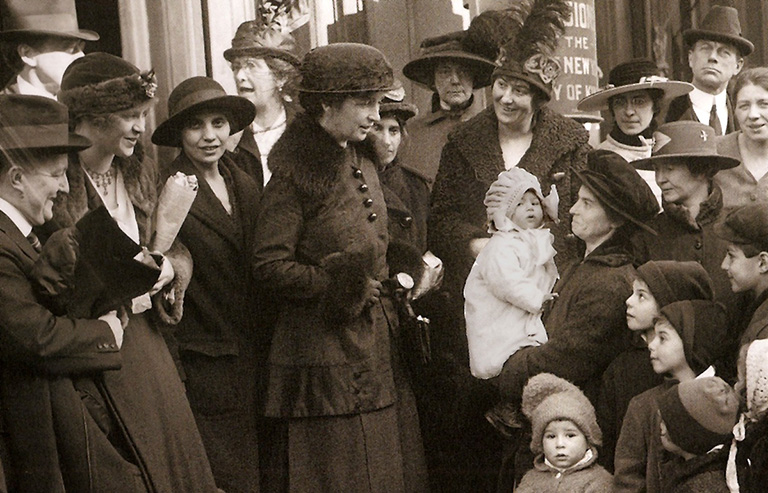“No woman can call herself free until she can choose consciously whether she will or will not be a mother.” – Margaret Sanger
Planned Parenthood celebrates it’s 100 birthday on October 16, 2016. Even though birth control is now more readily available, the battle for reproductive rights and sexual freedom still continues. Let’s look back at the origin of Planned Parenthood, and its founder Margaret Sanger.
Margaret Louise Higgins was born on September 14, 1879, in Corning, New York to Michael Hennessy Higgins and Anne Purcell Higgins, the sixth out of eleven children. Margaret’s father made a meager living carving gravestones. He was an agnostic, an abolitionist, and supported suffrage. From an early age, Margaret and her siblings were encouraged to share their opinions. This was unheard of in a time where children were to be seen and not heard.
Despite Michael being open minded, the family still held to very traditional gender roles. Anne was a devout Catholic. She cooked, cleaned and cared for everyone in the household. On top of that, she went through 18 pregnancies in 22 years, with several miscarriages. Two didn’t survive to adulthood. By the time she died at the young age of 49, she had looked much older than her years. Margaret was desperate to get away from the overcrowded house, crushing poverty, and taunting by the other children. Her older sisters pooled their money together to send Margaret to Claverack College and Hudson River Institute in 1896, despite their father’s disapproval. He felt nursing was an inappropriate career for his daughter to pursue She spent three years there then rushed home to take care of her ailing mother. She cared for her family after her mother died.
In 1900, Margaret went to New York City and became a nurse probationer at White Planes Hospital. There she met architect and aspiring artist, William Sanger. Margaret was smitten with Bill, and they married in 1902. Bill shared Margaret’s penchant for socialism and radical thinking. At first, they tried to settle down in Hastings-on-Hudson, New York but the builders of their new house had neglected to put an asbestos covering on the heating pipes causing a fire that destroyed their home. The Sangers moved to New York City in 1911 and became heavily involved in the artist community as well as workers rights and the labor movement.
Margaret worked as a visiting nurse in the slums of the east side during this time. There she saw the same issues she grew up with, large families living in poverty. Many mothers became so desperate they performed self-induced abortions. The curse of the working class, mostly immigrant women, was the lack of information about contraception. There wasn’t any way these women could learn how to stop getting pregnant; it’s was illegal and was considered an obscenity thanks to our old friend Anthony Comstock. Not only was it hard for the families to have so many mouths to feed with so little money coming in but also it took its toll on the women. Frequent pregnancies also meant more miscarriages and the steps they often took to end a pregnancy could be fatal. Margaret decided something had to be done and took on the crusade to give women more control and choice when it came to procreation.
This crusade came at a price. Margaret sought out all the information to could find about contraception. In 1912 she wrote What Every Mother Should Know then What Every Girl Should Know for the socialist magazine New York Call. Some welcomed the open discussion of sex while others were shocked by it. In 1913, she traveled to Scotland and France to do research on birth control. She would not return to the U.S. with Bill. Bill stayed in Paris to continue his work as an artist while Margaret returned to NY to pursue her work. Margaret and Bill’s separation sounds amicable in her autobiography. She did not want to keep him from pursuing his art, and he did not want her to have to stay and give up her mission. They finally divorced in 1921 and Margaret would marry again in 1922 to Noah Slee.
In 1914, Margaret and a group of friends came up with the new term “birth control” when they formed the National Birth Control League. She started a magazine called The Woman Rebel, which was considered obscene and thus illegal to distribute. Margaret found herself looking at jail time. When the judge and lawyers tried to pressure her into pleading guilty then promising not to break the law again in return for dismissal of the charges, Margaret decided to flee the country. This was a difficult decision since she now had two sons and a daughter and had been struggling with tuberculosis for some time.
Margaret spent her time in Europe learning everything she could about family limitation and sex education. She spent a great deal of time with Havelock Ellis, who’s Psychology of Sex was blowing everyone’s mind and the Neo-Malthusians. She traveled to England, France, Germany, and the Netherlands where she learned that other countries had a much more liberal attitude towards birth control, especially the Netherlands. Margaret mailed copies of The Woman Rebel while in Europe and prepared to publish her pamphlet, Family Limitation, upon her return.
Margaret eventually returned to the US. Being apart from her children for so long was difficult, and she was worried about her daughter’s health. Margaret managed to get the charges against her dropped despite Comstock tricking her husband into giving an undercover cop a copy of Family Limitation, which resulted in his arrest and jail time. She needed to offer more than the printed word, so she embarked on a cross-country speaking tour. Upon her return to New York, she set up a clinic to help women one on one. On October 16th, 1916, Margaret, her sister Ethel Byrne, and volunteer Fania Mindell opened the first birth control clinic, The Brownsville Clinic, in the US in Brooklyn. Nine days later they were arrested and put in jail. Their crime was distributing information about contraception, selling obscene books, and being a public nuisance.
In 1917, Margaret started The Birth Control Review, a scientific journal. 1921 saw the first American Birth Control Conference held in New York City. Margaret opened the Birth Control Clinical Research Bureau in 1923. She then started the National Committee on Federal Legislation for Birth Control to eliminate the Comstock laws. In 1939 the American Birth Control League merged with the Clinical Research Bureau to become the Birth Control Federation of America. Members of the BCFA decided to change the name to something more conservative so, in 1942, Planned Parenthood Federation of America was born.
Margaret lived to see the debut of The Pill in 1960 and birth control legalized for married couples in 1965 before she passed away on September 6th, 1966.
Want to read more about Margaret Sanger? Buy The Autobiography of Margaret Sanger.
(affiliate link)


